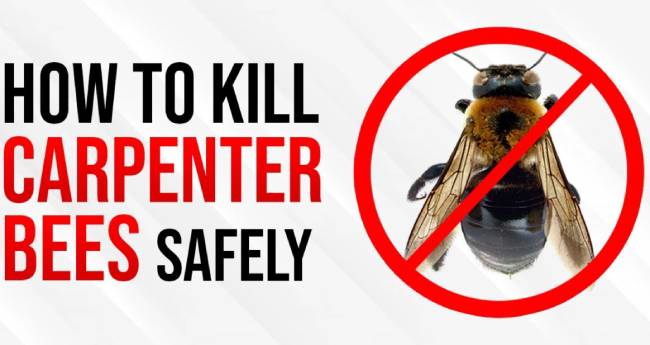It can be a real hassle to deal with carpenter bees. Often seen buzzing around dwellings and other structures where they like to build their nests, they resemble large bumblebees. In addition to tunneling into decks, porches, and other wood structures, they cause millions of dollars in damage to dwellings each year.
During mating season, they can also be aggressive, flying very close to humans and even bumping into them. The good news is that they rarely sting people and their nests can be removed.
Table of Contents
Carpenter Bee Basics
In the United States, there are several species of carpenter bees, but the Virginia carpenter bee (Xylocopa virginica) is the most common. They are found throughout the Southeast, but they can also be found in Connecticut to the north and Texas to the west. Bumblebees and carpenter bees look very similar, but they’re not the same. Carpenter bees range in size from about 5/8 of an inch to 1 inch.
A bumblebee (genus Bombus) nests in the ground, usually in abandoned rodent nests, and lives in social groups. The carpenter bee (genus Xylocopa) burrows into wood. Examine the dorsal (upper) side of the abdomen to distinguish between the two. An unfurled and shiny carpenter bee is a carpenter bee. Bumblebees, on the other hand, have hairy abdomens. Due to their excellent pollination abilities, both insects are considered beneficial. It is therefore recommended that you do not eliminate these insects unless absolutely necessary.
The average lifespan of a carpenter bee is one year. Each new generation hatches in the late summer, emerges from nests in August and September to feed and grow, pollinating flowers along the way before hibernating for the winter. The survivors emerge in April and May to mate. For her offspring, the female carpenter bee excavates a tunnel. She lays eggs and stores food in each brood chamber. The adult carpenter bees die off in July, leaving the new generation to continue the cycle when they emerge a month or so later.
In April and May, carpenter bees are just emerging to mate. Carpenter bees tend to hover around nest openings during this time, looking for receptive females. In addition to hovering aggressively around people who approach the nests, it can be rather unnerving being around them. There is even a possibility that they will fly right into you. However, male carpenter bees cannot sting despite their tough act. Carpenter bees can sting, but almost never do.

How to Identify Nests
You can tell you’re looking at a carpenter bee nest if you see a bee emerging from a hole in the ground or inside a structure. If you want to be sure, check the entrance holes. Carpenter bees make entrance holes that are about 12 inches in diameter, slightly bigger than their bodies. Tunnels are usually made against the grain of wood for the first inch or two. In the direction of the wood grain, the bee then turns right and extends the tunnel another four to six inches. You might see yellow stains on the surface of the wood just below the entrance hole due to carpenter bees eliminating their waste before entering their nests.
In spite of burrowing into wood, carpenter bees do not eat wood like termites. Due to the limited size of their nest tunnels, they rarely cause serious structural damage. Female carpenter bees, however, prefer refurbishing existing tunnels over digging new ones since such excavation requires a lot of energy. Nevertheless, if carpenter bees tunnel in the same structure year after year, the cumulative damage can be severe.
How to Control Carpenter Bees
The best defense is a good offense. The Carpenter Bee prefers to excavate untreated, unfinished wood. Painting or varnishing your home’s exterior can prevent carpenter bees from nesting in the first place. The carpenter bees must be eliminated with an insecticide if an infestation has occurred. Sprays or dust can reach the interior surface of entrance holes, as recommended by many professionals. Carpenter bees are least active at dusk, when the pesticide should be applied.
In order for the insecticide to work, the bees must come into contact with it as they crawl through the nest’s entrance hole. The appropriate insecticidal dust should be applied in the spring, just before adults emerge to mate. If you have seen the bees emerge from the nest, you should wait a few days before you fill in the holes with wood putty or filler after they emerge. When the spring adults emerge, if you did not apply the insecticide before the spring adults emerged, you will need to treat the nests in the spring and again in late summer, when the next generation of adults is foraging for food. The nest holes should be sealed with steel wool in the fall, followed by the filling in of the holes with putty, wood filler, fiberglass, or asphalt in the spring.
In case you have a large infestation, you should consider hiring a professional pest control company, especially if you have specialized tools that can be used to reach deep into crevices, especially in case you have a large infestation. In any case, the good news is that if you would like to treat your own flying insects, you should be able to use any name-brand insecticide that is designed specifically to kill flying insects in the event that you want to do so. There are several natural remedies that you can choose from, such as boric acid, Diatomaceous Earth, and citrus spray, for instance, if you prefer to use a natural remedy. Alternatively, you may wish to contact the local extension office in your area to find out which insecticides are safe to use on carpenter bees in your area and which are effective at killing them.
